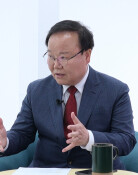Reversal of interest rates puts Bank of Korea at challenge
Reversal of interest rates puts Bank of Korea at challenge
Posted March. 23, 2018 07:58,
Updated March. 23, 2018 08:00
The U.S. Federal Reserve’s decision to raise base interest rates by 0.25 percentage point to 1.50-1.75 percent on Wednesday (local time) has put U.S. interest rates higher than that of Korea (1.50 percent) for the first time in 10 years and seven months since August 2007. Among the 15 Fed board members, eight have predicted that two more hikes will be carried out within this year, while seven anticipated three, confirming the U.S. government’s determination to tighten the economy in response to recovery.
“It is early to predict capital outflow at this stage,” said Bank of Korea Governor Lee Ju-yeol, in response to concerns of capital outflow from the domestic market, as the Fed’s actions met expectations and recent capital market flows are more reflective of corporate performance or national credit ratings rather than interest rate divergence. Amicable inter-Korean relations have reduced geopolitical risk, strengthening incentives to invest.
However, Korea cannot afford to just simply sit and watch U.S. interest hikes. The tightening policy of the United States and Europe has put Korea in a position to follow suit. Even if Korea does raise rates one or two times this year, it will still be difficult to reduce the gap with the U.S. rate. If the reversal of key interest rates persists or even intensify, this may incur capital outflow and thus trigger a foreign exchange crisis. On the other hand, Korea cannot afford to raise its interest rates in sync with the United States. Korea’s inflation rate still remains around 1 percent, with February figures standing at a mere 1.4 percent. Such economic indices prove that the economy recovery is not robust enough to withstand interest hikes.
Restructuring of mid-sized shipbuilding companies, issues at GM Korea and Kumho Tires can also negatively impact the economy. Over 70 percent of household debt, which amount to 1,450 trillion won, is based on variable interest rate, another key concern. If the interest burden on vulnerable groups and marginal firms intensify and lead to bankruptcy, the economy will rapidly deteriorate. Another reason why the Bank of Korea cannot afford fiscal austerity is the government’s drive to create more youth jobs and promote income-driven growth. We are dealing with the aftermath of failing to strengthen economic fundamentals during low interest rate period. It is up to the crisis management capabilities of government policies and monetary authorities to come up with detailed plans to minimize future shocks.
Headline News
- Med professors announce intention to leave hospitals starting Thursday
- Bridge honoring Sgt. Moon Jae-sik unveiled in Pennsylvania
- Chief of Staff Chung tells presidential secretaries to stay away from politics
- US FTC bans noncompete agreements
- N. Korea launches cyberattacks on S. Korea's defense companies







